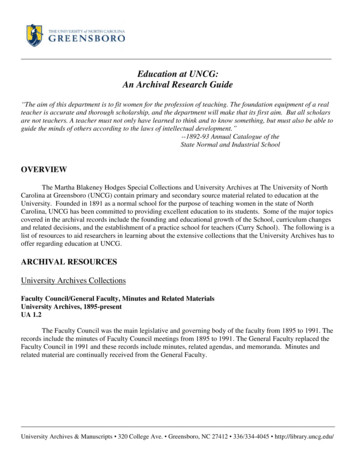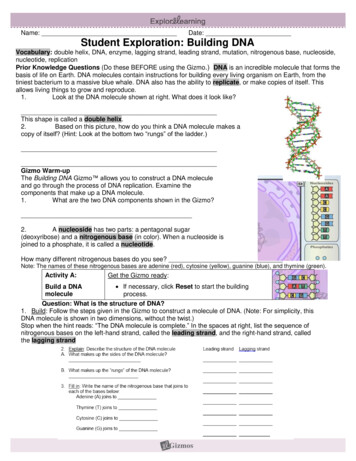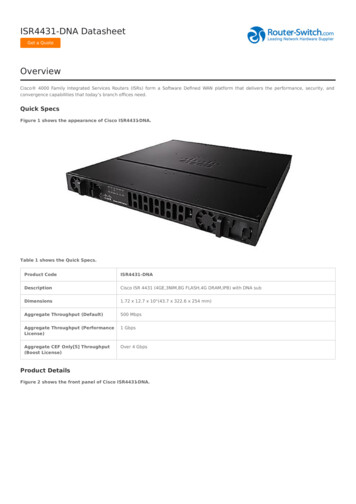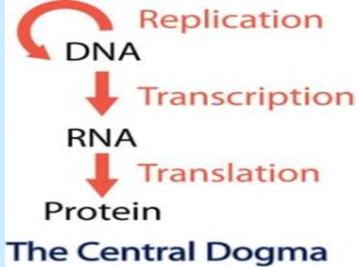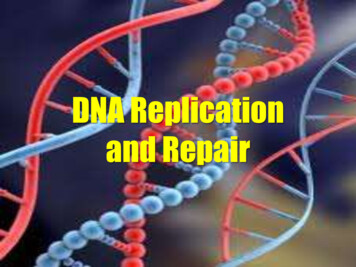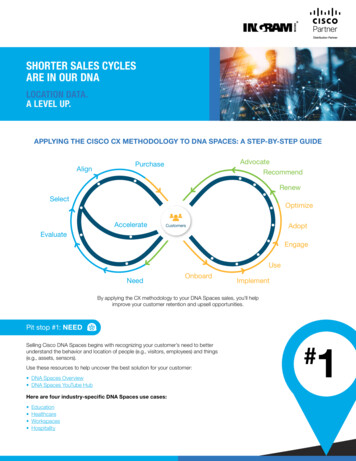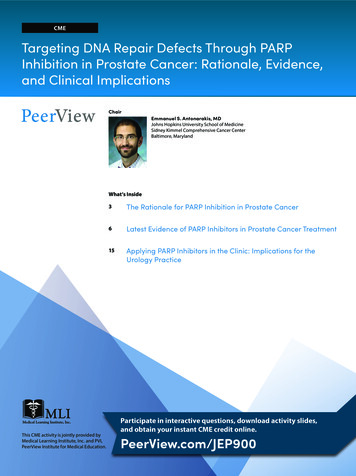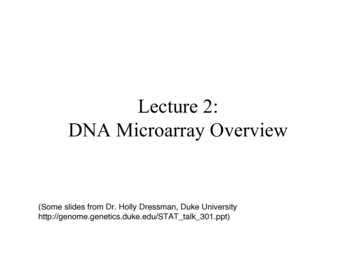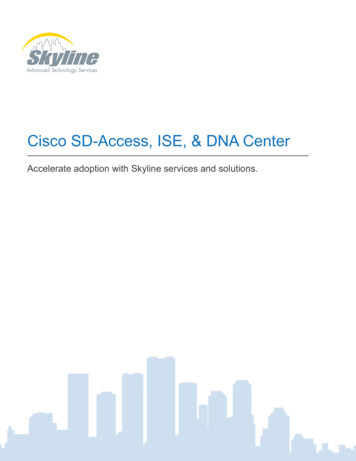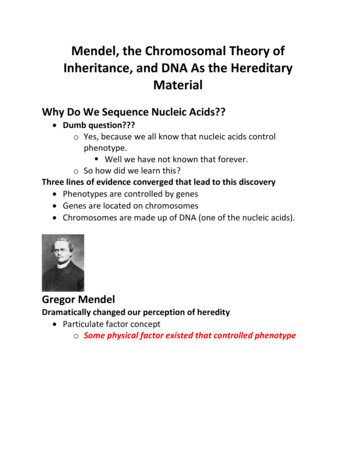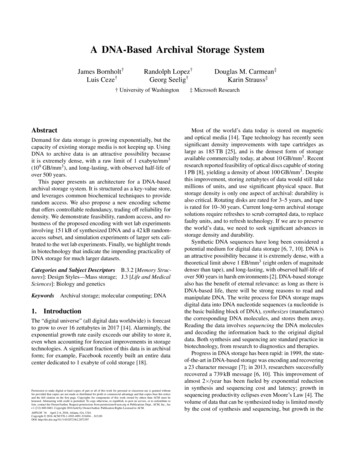
Transcription
A DNA-Based Archival Storage SystemJames Bornholt†Luis Ceze†Randolph Lopez†Georg Seelig†† University of WashingtonAbstractDemand for data storage is growing exponentially, but thecapacity of existing storage media is not keeping up. UsingDNA to archive data is an attractive possibility becauseit is extremely dense, with a raw limit of 1 exabyte/mm3(109 GB/mm3 ), and long-lasting, with observed half-life ofover 500 years.This paper presents an architecture for a DNA-basedarchival storage system. It is structured as a key-value store,and leverages common biochemical techniques to providerandom access. We also propose a new encoding schemethat offers controllable redundancy, trading off reliability fordensity. We demonstrate feasibility, random access, and robustness of the proposed encoding with wet lab experimentsinvolving 151 kB of synthesized DNA and a 42 kB randomaccess subset, and simulation experiments of larger sets calibrated to the wet lab experiments. Finally, we highlight trendsin biotechnology that indicate the impending practicality ofDNA storage for much larger datasets.Categories and Subject Descriptors B.3.2 [Memory Structures]: Design Styles—Mass storage; J.3 [Life and MedicalSciences]: Biology and geneticsKeywords Archival storage; molecular computing; DNA1. IntroductionThe “digital universe” (all digital data worldwide) is forecastto grow to over 16 zettabytes in 2017 [14]. Alarmingly, theexponential growth rate easily exceeds our ability to store it,even when accounting for forecast improvements in storagetechnologies. A significant fraction of this data is in archivalform; for example, Facebook recently built an entire datacenter dedicated to 1 exabyte of cold storage [18].Permission to make digital or hard copies of part or all of this work for personal or classroom use is granted withoutfee provided that copies are not made or distributed for profit or commercial advantage and that copies bear this noticeand the full citation on the first page. Copyrights for components of this work owned by others than ACM must behonored. Abstracting with credit is permitted. To copy otherwise, to republish, to post on servers, or to redistribute tolists, contact the Owner/Author. Request permissions from permissions@acm.org or Publications Dept., ACM, Inc., fax 1 (212) 869-0481. Copyright 2016 held by Owner/Author. Publication Rights Licensed to ACM.ASPLOS ’16 April 2–6, 2016, Atlanta, GA, USACopyright 2016 ACM 978-1-4503-4091-5/16/04. . . 15.00DOI: http://dx.doi.org/10.1145/2872362.2872397Douglas M. Carmean‡Karin Strauss‡‡ Microsoft ResearchMost of the world’s data today is stored on magneticand optical media [14]. Tape technology has recently seensignificant density improvements with tape cartridges aslarge as 185 TB [25], and is the densest form of storageavailable commercially today, at about 10 GB/mm3 . Recentresearch reported feasibility of optical discs capable of storing1 PB [8], yielding a density of about 100 GB/mm3 . Despitethis improvement, storing zettabytes of data would still takemillions of units, and use significant physical space. Butstorage density is only one aspect of archival: durability isalso critical. Rotating disks are rated for 3–5 years, and tapeis rated for 10–30 years. Current long-term archival storagesolutions require refreshes to scrub corrupted data, to replacefaulty units, and to refresh technology. If we are to preservethe world’s data, we need to seek significant advances instorage density and durability.Synthetic DNA sequences have long been considered apotential medium for digital data storage [6, 7, 10]. DNA isan attractive possibility because it is extremely dense, with atheoretical limit above 1 EB/mm3 (eight orders of magnitudedenser than tape), and long-lasting, with observed half-life ofover 500 years in harsh environments [2]. DNA-based storagealso has the benefit of eternal relevance: as long as there isDNA-based life, there will be strong reasons to read andmanipulate DNA. The write process for DNA storage mapsdigital data into DNA nucleotide sequences (a nucleotide isthe basic building block of DNA), synthesizes (manufactures)the corresponding DNA molecules, and stores them away.Reading the data involves sequencing the DNA moleculesand decoding the information back to the original digitaldata. Both synthesis and sequencing are standard practice inbiotechnology, from research to diagnostics and therapies.Progress in DNA storage has been rapid: in 1999, the stateof-the-art in DNA-based storage was encoding and recoveringa 23 character message [7]; in 2013, researchers successfullyrecovered a 739 kB message [6, 10]. This improvement ofalmost 2 /year has been fueled by exponential reductionin synthesis and sequencing cost and latency; growth insequencing productivity eclipses even Moore’s Law [4]. Thevolume of data that can be synthesized today is limited mostlyby the cost of synthesis and sequencing, but growth in the
biotechnology industry portends orders of magnitude costreductions and efficiency improvements.We think the time is ripe to consider DNA-based storage seriously and explore system designs and architecturalimplications. This paper presents an architecture for a DNAbacked archival storage system, modeled as a key-value store.A DNA storage system must overcome several challenges.First, DNA synthesis and sequencing is far from perfect, witherror rates on the order of 1% per nucleotide. Sequencescan also degrade while stored, further compromising data integrity. A key aspect of DNA storage is to devise appropriateencoding schemes that can tolerate errors by adding redundancy. Existing approaches have focused on redundancy buthave ignored density implications. In this work we proposea new encoding scheme that offers controllable redundancy,enabling different types of data (e.g., text and images) to havedifferent levels of reliability and density. The density of ourencoding scheme outperforms existing work while providingsimilar reliability.Second, randomly accessing data in DNA-based storageis problematic, resulting in overall read latency that is muchlonger than write latency. Existing work has provided onlylarge-block access: to read even a single byte from storage,the entire DNA pool must be sequenced and decoded. Wepropose a method for random access that uses a polymerasechain reaction (PCR) to amplify only the desired data, biasingsequencing towards that data. This design both acceleratesreads and ensures that an entire DNA pool need not besequenced.We demonstrate the feasibility of our system design with aseries of wet lab experiments, in which we successfully storeddata in DNA and performed random access to read backonly selected values. We further evaluate our design usingsimulations to understand the error-correction characteristicsof different encoding schemes, assess their overheads, andmake projections about future feasibility based on technologytrends. Our results demonstrate the impending practicalityof DNA-based archival storage as a solution to exponentialgrowth in demand for data storage.are the “reverse complement” of each other. Two strands donot need to be fully complementary to bind to one another.Such partial complementarity is useful for applications inDNA nanotechnology and other fields, but can also result inundesired “crosstalk” between sequences in complex reactionmixtures containing many sequences.Selective DNA amplification with polymerase chain reaction (PCR). PCR is a method for exponentially amplifyingthe concentration of selected sequences of DNA within a pool.A PCR reaction requires four main components: the template,sequencing primers, a thermostable polymerase and individual nucleotides that get incorporated into the DNA strandbeing amplified. The template is a single- or double-strandedmolecule containing the (sub)sequence that will be amplified.The DNA sequencing primers are short synthetic strands thatdefine the beginning and end of the region to be amplified.The polymerase is an enzyme that creates double-strandedDNA from a single-stranded template by “filling in” individual complementary nucleotides one by one, starting from aprimer bound to that template. PCR happens in “cycles”, eachof which doubles the number of templates in a solution. Theprocess can be repeated until the desired number of copies iscreated.2. Background on DNA ManipulationDNA synthesis. Arbitrary single-strand DNA sequencescan be synthesized chemically, nucleotide by nucleotide [15,17]. The coupling efficiency of a synthesis process is theprobability that a nucleotide binds to an existing partialstrand at each step of the process. Although the couplingefficiency for each step can be higher than 99%, this smallerror still results in an exponential decrease of product yieldwith increasing length and limits the size of oligonucleotidesthat can be efficiently synthesized to about 200 nucleotides.In practice, synthesis of a given sequence uses a large numberof parallel start sites and results in many truncated byproducts(the dominant error in DNA synthesis), in addition to manycopies of the full length target sequence. Thus, despite errorsin synthesizing any specific strand, a given synthesis batchwill usually produce many perfect strands. Moreover, modernarray synthesis techniques [15] can synthesize complex poolsof nearly 105 different oligonucleotides in parallel.DNA basics. Naturally occurring DNA consists of fourtypes of nucleotides: adenine (A), cytosine (C), guanine (G),and thymine (T). A DNA strand, or oligonucleotide, is alinear sequence of these nucleotides. The two ends of aDNA strand, referred to as the 5′ and 3′ ends, are chemicallydifferent. DNA sequences are conventionally representedstarting with the 5′ nucleotide end. The interactions betweendifferent strands are predictable based on sequence. Twosingle strands can bind to each other and form a double helixif they are complementary: A in one strand aligns with Tin the other, and likewise for C and G. The two strands ina double helix have opposite directionality (5′ end bindsto the other strand’s 3′ end), and thus the two sequencesDNA sequencing. There are several high-throughput sequencing techniques, but the most popular methods (such asthat used by Illumina) use DNA polymerase enzymes andare commonly referred to as “sequencing by synthesis”. Thestrand of interest serves as a template for the polymerase,which creates a complement of the strand. Importantly, fluorescent nucleotides are used during this synthesis process.Since each type of fluorescent nucleotide emits a differentcolor, it is possible to read out the complement sequenceoptically. Sequencing is error-prone, but as with synthesis,in aggregate, sequencing typically produces enough precisereads of each strand.
Transistors on Chip1010DNA storage libraryDataINReading DNAProductivityWriting DNA102DNApoolPCRThermocycler106DataOUT104DNA SequencerFigure 3. Overview of a DNA storage system.19701980199020002010YearFigure 1. Carlson curves [4]: trends in DNA synthesis andsequencing technology compared to Moore’s Law. DNAproductivity is measured in nucleotides per person per day.Recent growth in sequencing technology eclipses Moore.Access TimeDurabilityFlashms 5 yrsHDD10s ms 5 yrsTapeminutes 15-30 yrsDNA Storage10s hrscenturiesFigure 2. DNA storage as the bottom level of the storagehierarchySequencing and synthesis improvement projections. Today, neither the performance nor the cost of DNA synthesisand sequencing is viable for data storage purposes. However,they have historically seen exponential improvements. Theircost reductions and throughput improvements have been compared to Moore’s Law in Carlson’s Curves [4], as shown inFigure 1. It shows that sequencing productivity has beengrowing faster than Moore’s Law. Important biotechnologyapplications such as genomics and the development of smartdrugs are expected to continue driving these improvements,eventually making data storage a viable application.3. A DNA Storage SystemWe envision DNA storage as the very last level of a deepstorage hierarchy, providing very dense and durable archivalstorage with access times of many hours to days (Figure 2).DNA synthesis and sequencing can be made arbitrarilyparallel, making the necessary read and write bandwidthsattainable. We now describe our proposal of a system forDNA-based storage with random access support.3.1DNA Synthesizer108OverviewA DNA storage system consists of a DNA synthesizer thatencodes the data to be stored in DNA, a storage containerwith compartments that store pools of DNA that map to avolume, and a DNA sequencer that reads DNA sequencesand converts them back into digital data. Figure 3 shows anoverview of the integrated system.The basic unit of DNA storage is a DNA strand that isroughly 100-200 nucleotides long, capable of storing 50-100bits total. Therefore, a typical data object maps to a very largenumber of DNA strands. The DNA strands will be stored in“pools” that have stochastic spatial organization and do notpermit structured addressing, unlike electronic storage media.Therefore, it is necessary to embed the address itself into thedata stored in a strand. This way, after sequencing, one canreassemble the original data value. We discuss digital datarepresentation in DNA in Section 4.3.2Interface and AddressingA storage system needs a way to assign identification tagsto data objects so they can be retrieved later. We choose asimple key-value architecture, where a put(key, value)operation associates value with key, and a get(key) operation retrieves the value assigned to key. To implementa key-value interface in a DNA storage system, we need:(1) a function that maps a key to the DNA pool (in the library) where the strands that contain data reside; and (2) amechanism to selectively retrieve only desired portions of apool (i.e, random access), since the DNA container will likelystore significantly more data than the desired object.We implement random access by mapping a key to a pairof PCR primers. At write time, those primers are added to thestrands. At read time, those same primers are used in PCRto amplify only the strands with the desired keys. Becausethe resulting pool will have a much higher concentration ofthe desired strands, a sample from that pool is very likely tocontain all of those strands.Separating the DNA strands into a collection of pools(Figure 3) balances a trade-off between storage density,reliability, and performance. The most dense way to storedata would be to have all strands in a single pool, but thisarrangement sacrifices reliability for two reasons. First, asingle pool requires many different primers to distinguish allkeys, which increases the chance that two primers react poorlyto each other. Second, a single pool reduces the likelihood thata random sample drawn during the read process will containall the desired data. On the other hand, using a separate poolper key sacrifices density excessively. We therefore use alibrary of reasonably-sized pools, and use random accesswithin each pool.
DNA Storage SystemMap to PrimerSequencekeyATCCGTATCEncode as HighBits of Addressfoo.txtGTACTCTranslate toNucleotidesvalue1101000100 AGATCGCT Encode NA Library(a) The write process performs put(key, value), generating a DNA library.DNA Storage SystemMap to selected strandsare amplifiedDNA Librarycontaining severalkey,value pairsPCRAmplificationSequencingGCCATGACTCGA GCCATGCCTCGA GCCATGACTAGA GCCATGCCTCGA Decodevalue1101000100 (b) The read process performs get(key) on a DNA library, returning the value.Figure 4. Overview of a DNA storage system operation as a key-value store.3.3System OperationFigure 4 shows flowcharts for the write (put) and read(get) processes in more detail. The write process (Fig. 4(a))takes as input the key and value to store. It uses the key toobtain the PCR primer sequences, compute the high part ofthe address, and to determine the pool in the DNA librarywhere the resulting strands will be stored. The low part of theaddress indexes the multiple strands generated by chunkingthe value (see Sec. 4.2). Next, it encodes the data addresses,payloads, and error detection codes, and attaches the primertarget sequences, to produce final DNA sequences for thesynthesizer to manufacture. The resulting DNA moleculesare stored in the storage library for archival.The read process (Fig. 4(b)) takes as input a key. It usesthe key to obtain the PCR primer sequences that identifymolecules in the pool associated with that key. Next, thestorage system physically extracts a sample from the DNApool that contains the stored data, but likely also includeslarge amounts of unrelated data. The sample and the PCRprimers are sent to the PCR thermocycler, which amplifiesonly the desired strands. The resulting pool goes to the DNAsequencer, which ultimately produces the digital data readout.Note that this process might be iterative since it may requiremultiple samples and sequencing steps to extract all the dataassociated with the desired keys. The DNA synthesizer is usedfor both producing the DNA strands that hold data payloadas well as synthesizing the PCR primers used to amplify dataduring the random access read process.The read process removes a sample of DNA from the pool,and so cumulative reads reduce the quantity of DNA availablefor future operations. But DNA is easy to replicate, and sothe pools can easily be replenished after read operations ifnecessary. If successive amplification is problematic, a poolcan also be completely resynthesized after a read operation.4. Representing Data in DNAWhile DNA has many properties that make it different fromexisting storage media, there are parallels between traditionalstorage and DNA storage. At the lowest levels, traditionalstorage media store raw bits. The storage device abstracts thephysical media, which could be magnetic state, or the chargein a capacitor, or the stable state of a flip-flop, and presentsto the storage hierarchy raw digital data. In a similar way,the abstraction of DNA storage is the nucleotide: though anucleotide is an organic molecule consisting of one base (A,C, G, or T) and a sugar-phosphate backbone, the abstractionof DNA storage is as a contiguous string of quaternary(base-4) numerals. This section describes the challenges ofrepresenting data in DNA, and presents several encodingsthat overcome these challenges.4.1RepresentationThe obvious approach to store binary data in DNA is toencode the binary data in base 4, producing a string ofn/2 quaternary digits from a string of n binary bits. Thequaternary digits can then be mapped to DNA nucleotides(e.g., mapping 0, 1, 2, 3 to A, C, G, T, respectively). Forexample, the binary string 01110001 maps to the base-4string 1301, and then to the DNA sequence CTAC. However,DNA synthesis and sequencing processes are prone to a widevariety of errors (substitutions, insertions, and deletions ofnucleotides), requiring a more careful encoding.The likelihood of some forms of error can be reducedby encoding binary data in base 3 instead of base 4 [10], asFigure 5(a) illustrates. Each ternary digit maps to a DNAnucleotide based on a rotating code (Figure 5(b)) that avoidsrepeating the same nucleotide twice. This encoding avoidshomopolymers—repetitions of the same nucleotide that significantly increase the chance of sequencing errors [20].
Binary dataBase 3Huffman codeDNAnucleotidesPolya;01010000 01101111 01101100 01111001 01100001 0011101112011021100210122211101112222021Output StrandGCGAGTGAGTATCGATGCTCTAGAGCATGTGA(a) Translating binary data to DNA nucleotides via a Huffman code.Ternary DigitTo EncodePrevious NucleotideACGT0CGTA1GTAC2TACG(b) A rotating encoding to nucleotides avoids homopolymers (repetitions of the same nucleotide), which are error-prone.Figure 5. Encoding a stream of binary data as a s
eventually making data storage a viable application. 3. A DNA Storage System We envision DNA storage as the very last level of a deep storage hierarchy, providing very dense and durable archival storage
